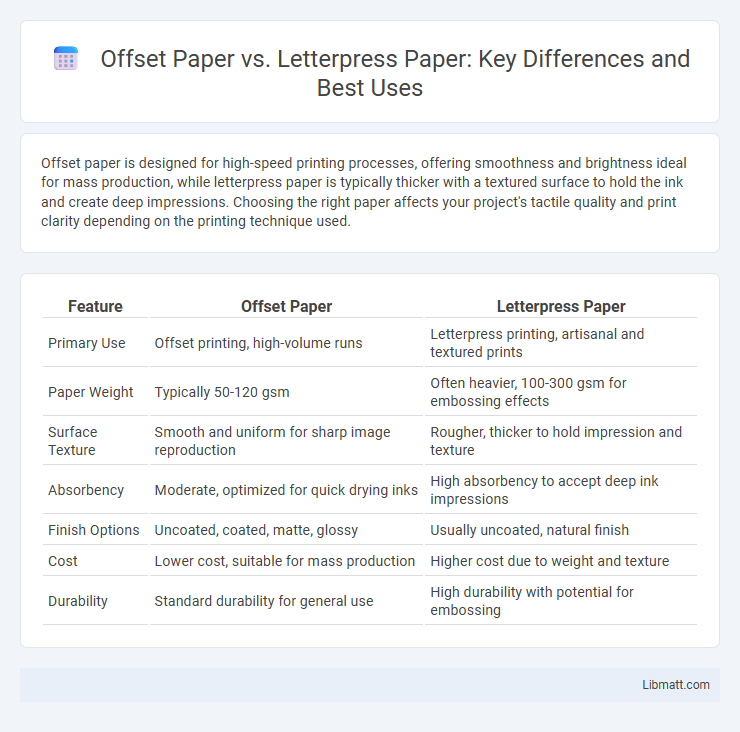Offset paper is designed for high-speed printing processes, offering smoothness and brightness ideal for mass production, while letterpress paper is typically thicker with a textured surface to hold the ink and create deep impressions. Choosing the right paper affects your project's tactile quality and print clarity depending on the printing technique used.
Table of Comparison
| Feature | Offset Paper | Letterpress Paper |
|---|---|---|
| Primary Use | Offset printing, high-volume runs | Letterpress printing, artisanal and textured prints |
| Paper Weight | Typically 50-120 gsm | Often heavier, 100-300 gsm for embossing effects |
| Surface Texture | Smooth and uniform for sharp image reproduction | Rougher, thicker to hold impression and texture |
| Absorbency | Moderate, optimized for quick drying inks | High absorbency to accept deep ink impressions |
| Finish Options | Uncoated, coated, matte, glossy | Usually uncoated, natural finish |
| Cost | Lower cost, suitable for mass production | Higher cost due to weight and texture |
| Durability | Standard durability for general use | High durability with potential for embossing |
Introduction: Understanding Offset Paper vs Letterpress Paper
Offset paper is designed for high-speed offset printing presses, featuring smooth, uniform surfaces that absorb ink evenly for sharp, consistent images. Letterpress paper, often thicker with a softer texture, is chosen for its ability to withstand the pressure of letterpress printing, resulting in tactile, debossed impressions. The key differences lie in their finish, weight, and absorbency, tailored to optimize performance for each specific printing technique.
What is Offset Paper?
Offset paper is a type of high-quality paper specifically designed for offset printing, a widely used commercial printing technique. It features a smooth, uncoated surface that ensures excellent ink absorption and sharp image reproduction, making it ideal for producing books, magazines, and brochures. Unlike letterpress paper, offset paper is optimized for high-speed printing presses and is available in various weights and finishes to suit different project needs.
What is Letterpress Paper?
Letterpress paper is a high-quality, thick, and absorbent paper specifically designed for letterpress printing, which uses a deep impression technique to create tactile, debossed effects. It typically features a soft texture and is made from cotton or other fibers that withstand the pressure of the printing plates without cracking or tearing. Compared to offset paper, letterpress paper excels in capturing fine details and maintaining crisp, clean edges, making it ideal for artisanal invitations, business cards, and other specialty printed materials.
Key Differences Between Offset and Letterpress Paper
Offset paper is typically smoother and thinner, designed for high-speed printing processes that require excellent ink absorption and fast drying times. Letterpress paper tends to be thicker, more textured, and often cotton-based, providing durability and the ability to hold deep impressions from the press. The key differences lie in the weight, surface texture, and fiber content, with offset paper optimized for efficiency and letterpress paper prioritized for tactile quality and craftsmanship.
Texture and Finish Comparison
Offset paper typically features a smooth, uniform texture designed for high-speed printing with sharp, clean finishes, making it ideal for everyday documents and mass production. Letterpress paper, on the other hand, boasts a thicker, more textured surface that enhances tactile quality and captures the deep impressions created by the letterpress technique, resulting in a distinct, artisanal finish. When choosing paper, your decision should consider how the texture and finish impact the final look and feel of your printed materials.
Print Quality on Offset vs Letterpress Paper
Offset paper offers smooth surfaces ideal for high-resolution, vibrant prints with fine details and sharp text. Letterpress paper features a thicker, textured composition that enhances tactile impressions and creates elegant debossed effects, giving prints a distinct artisanal quality. Your choice depends on whether you prioritize crisp, colorful images or sophisticated, tactile design elements.
Best Uses for Offset Paper
Offset paper excels in high-volume printing tasks such as brochures, flyers, and business cards, where cost-efficiency and consistent quality are essential. Its smooth surface and excellent ink absorption make it ideal for detailed images and fine text in commercial printing applications. Designed for use with offset printing presses, this paper supports sharp, vibrant colors, making it the preferred choice for marketing materials and large-scale print runs.
Best Uses for Letterpress Paper
Letterpress paper is ideal for wedding invitations, business cards, and high-end stationery due to its thick, textured surface that holds ink impression beautifully. Its ability to withstand deep impressions without tearing ensures sharp, elegant designs that elevate your printed materials. Choosing letterpress paper enhances tactile quality and visual appeal, making it perfect for premium, handcrafted printing projects.
Cost Comparison: Offset vs Letterpress
Offset paper generally costs less than letterpress paper due to mass production and widespread availability, making it a budget-friendly choice for large print runs. Letterpress paper is typically thicker, cotton-based, and produced in smaller quantities, leading to higher prices but offering superior texture and durability. Your decision should weigh the cost difference against the desired tactile quality and aesthetic impact of the final printed product.
Choosing the Right Paper for Your Project
Offset paper offers smoothness and cost-effectiveness ideal for mass printing projects with sharp, detailed images, while letterpress paper features a thicker, textured surface that enhances tactile quality and depth, perfect for luxury invitations or artisanal prints. Selecting the right paper depends on the desired finish, budget, and printing technique, with offset excelling in precision and speed, whereas letterpress provides a unique, embossed effect that elevates design sophistication. Understanding the compatibility of paper weight, ink absorption, and firmness ensures your project achieves both aesthetic appeal and functional durability.
Offset paper vs letterpress paper Infographic

 libmatt.com
libmatt.com